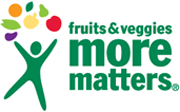September is “Fruits and Veggies: More Matters Month”, so we’re sharing some tips and resources from Fruitsandveggiesmorematters.org. We’d love to hear from ESD 112 staff members on what you do to make sure you eat enough fruits and veggies. Got any great tips or recipes? Please share them in the comments below!
In 2010 the USDA replaced their food pyramid with Healthy MyPlate Icon, which recommends that you should fill half your plate at each meal with fruits and veggies.
The current recommendations support fruits and vegetables as foods that should be eaten most often. And for most Americans, this means more than doubling the amount of fruits and vegetables they eat daily.
3 Reasons Support Why Eating MORE Fruits & Veggies Matters …
- Fruits and vegetables are major contributors of a number of nutrients that are under consumed in the U.S.—vitamins A, C and K, potassium, fiber and magnesium.
- Fruits and vegetables are associated with reduced risk of many chronic diseases.
- Fruits and vegetables are relatively low in calories which can replace high calorie foods that aid in weight gain.
New in the 2010 Dietary Guidelines
-
- Eating Behaviors. Eat breakfast, snack through out the day, consume fast food less often.
- Screen Time. Be aware of the correlation between screen time (television, video games, computer, etc.) and increased body weight.
- Plant Foods. Increase consumption of plant foods (vegetables, beans and peas, whole grains, nuts and seeds).
- Seafood. Seafood consumption of 8 oz per week is encouraged.
Focus on Making Changes in 4 Main Areas
1. Balance Calories to Manage Weight
2. Reduce Certain Foods and Food Components …
Sugar-Sweetened Beverages—Consume water, other calorie-free beverages, along with low fat (1%) or fat-free milk and 100% juice to meet total water recommendations.
Solid Fats*—Saturated fat from solid fats should equal less than 10% of total calories per day (butter, meat fat, margarine, shortening, heavy creams).
Refined Grains—Make half your grains whole grains.
Sodium—Consume less than 2,300 mg of sodium per day.
Further reduce intake to 1,500 mg per day for individuals 51 and older and those of any age who are African American or have hypertension (high blood pressure), diabetes, or chronic kidney disease.
3. Increase Certain Foods and Nutrients …
-
- Fill half your plate with fruits and vegetables at every meal and snacking occasion.
- Eat nutrient-dense foods and beverages most often—vegetables, fruits, whole grains, fat-free and low-fat (1%) milk and milk products, seafood, lean meats and poultry, eggs, beans and peas, nuts and seeds.
4. Build Healthy Eating Patterns …
-
- See some Weekly Healthy Menu Ideas



Leave A Comment